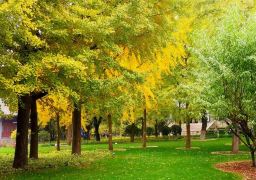The Qingyuan Palace was built in the fifth year of Zhengde in the Ming Dynasty (1510 AD) and has a history of nearly 500 years. Qingyuan Palace faces south and covers an area of more than 8,000 square meters. It is a traditional building with unique style and a composite courtyard layout. The entire temple is separated by a 10-meter-high fireproof wall. It has a brick, wood and stone structure with raised beams. The engraved reliefs are exquisitely crafted, with upturned eaves and corners, blue bricks and green tiles, and flagstone paving. In the three halls and one courtyard, the opera towers on both sides are symmetrical. The Wenwu Kuixing Towers and the men’s and women’s guest buildings are on the left and right respectively. There are 32 large round stone pillars supporting the front and rear main halls. There are towering ancient trees around the temple, creating a green shade and having distinct characteristics of the Ming and Qing Dynasties. Below the main entrance of Qingyuan Palace is a platform paved with flagstones. At the foot of the stone steps, there is a pair of stone lions smiling and welcoming guests. There are 40 steps of the stepped staircase in front of the palace, ascending step by step. The stone steps are 5.5 meters wide and 17 meters long obliquely. There are eight flower beds on each side of the steps. The mountain gate is a stone archway with six reliefs of Taoist legends on it. There is a smiling stone lion and a white marble lion on each side of the main mountain gate, facing each other symmetrically. Above the main gate is a stone archway engraved with the word “imperial edict”. There is a prime minister on each side, highlighting the solemn atmosphere of this palace being built by imperial order. Below is a horizontal inscription of about one chi with the three large characters “Qingyuan Palace”, with strong brushstrokes and a magnificent sight. Entering the mountain gate is the opera tower. The opera tower is made of stone and wood. It has a raised beam truss and a nine-ridge hip roof. The entire opera tower is supported by 14 large round stone pillars. The stage is 9 meters wide, 9 meters deep and 10 meters high in total, and the pillars are 7.6 meters high. In the middle of the opera tower, there is a huge plaque with the four characters “Spiritual Auspiciousness and Great Blessings”. In front of the stage, there is a large stone dam paved with flagstones measuring 14 meters long and 15 meters wide for people to watch operas and participate in temple fair activities. There are three incense burners, two incense racks and one lamp post in front of the stone dam. On both sides of the opera dam are the men’s and women’s guest buildings. According to the custom of men on the left and women on the right, people sit on different floors to watch operas. On the guest buildings, there is a newly built two-story Wenwu Kuixing Tower for the May Festival on each side. The literary Kuixing holds a pen! The military Kuixing holds a halberd. The bell and drum towers are on the left and right respectively. At the feet of the two corridors, there are wooden steles from the Ming and Qing Dynasties and inscriptions on steles for later renovations of Qingyuan Palace. Going up eight stone steps is the Chuanzhu Hall. It is 15 meters wide, 12 meters deep and 8 meters high in total. It is supported by 12 large red lacquered round stone pillars arranged symmetrically. It has a raised beam and cross-frame structure and a hard mountain-style roof. On the roof ridges and tiles, there are vivid sculptures of the Eight Immortals, a giant sea turtle, dragon heads with upturned corners and unicorns, seemingly about to soar into the clouds. Exiting the small mountain gate named “Gentle Breeze and Sweet Rain”, one enters the Qingyuan Garden. There are many rare and exotic flowers and plants in the garden, including the precious plant “Alsophila spinulosa” from the dinosaur era. There are 40 stone carvings and inscriptions. There are rockeries and a release pond. There is a hexagonal all-wooden Qingfeng Pavilion. The pavilion roof has two layers with glazed rafters and tiles, presenting a shape of facing the sky in June. The painted ceiling is decorated with patterns of dragons and phoenixes presenting auspiciousness and the twelve Chinese zodiac signs.
The pavilion has railings. Inside the pavilion, there are five long benches made of imitation pine wood in Songyuan Garden. There are also two sets of stone tables beside it for tourists to rest. There are 12 camphor trees beside the garden. The larger one is 30 meters high and has a diameter at breast height of 2.02 meters. It takes five people to encircle it.
Opening hours: open all day throughout the year.








